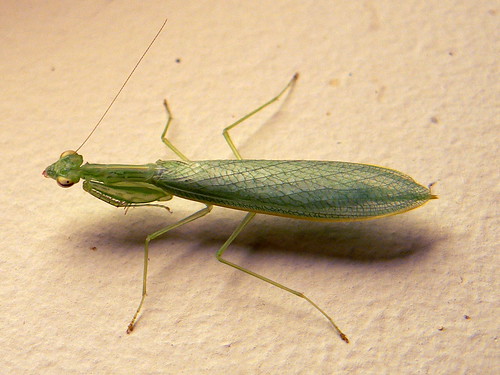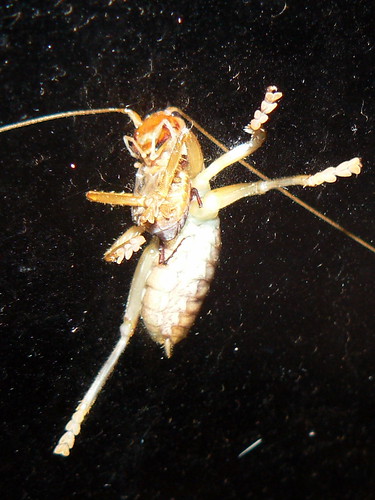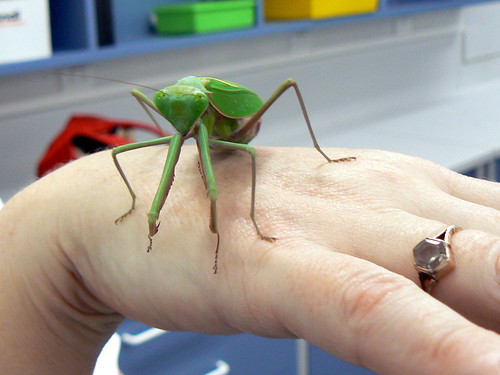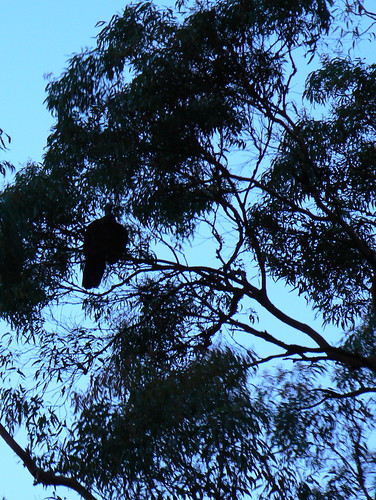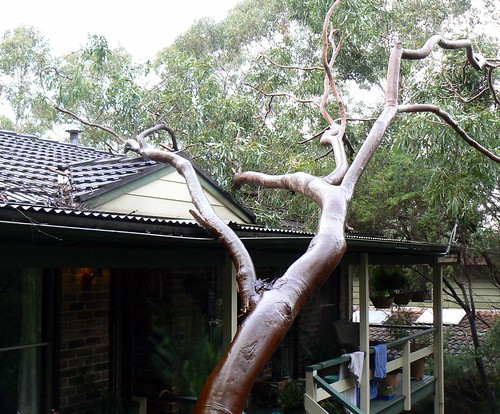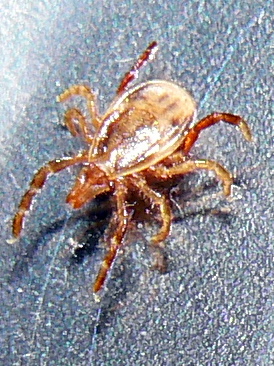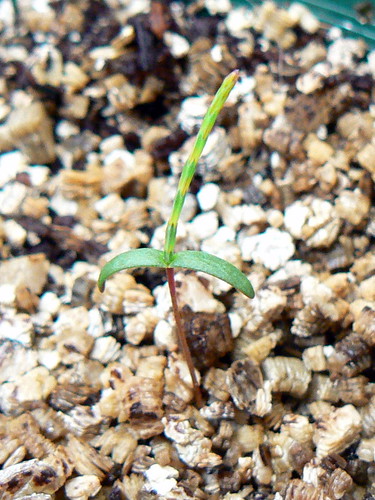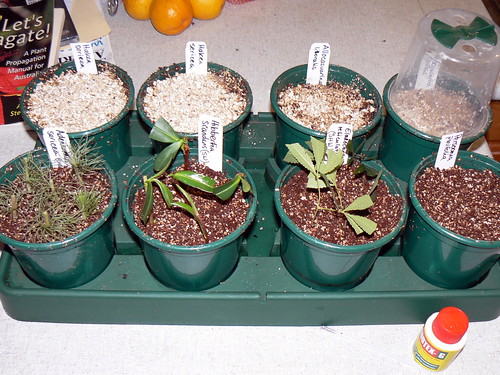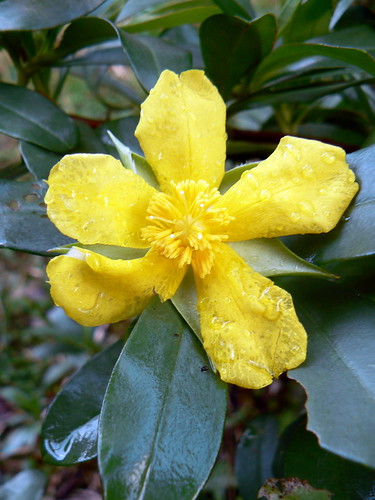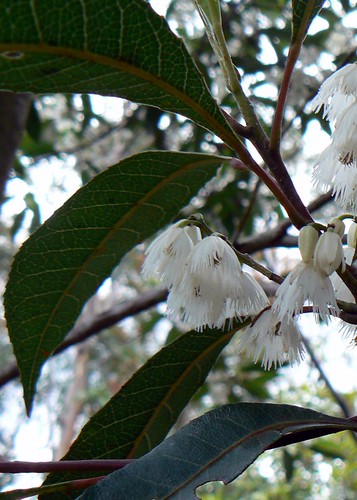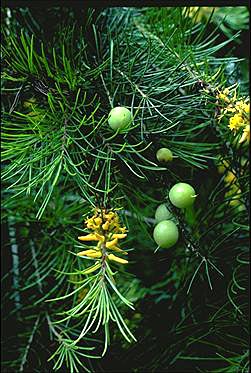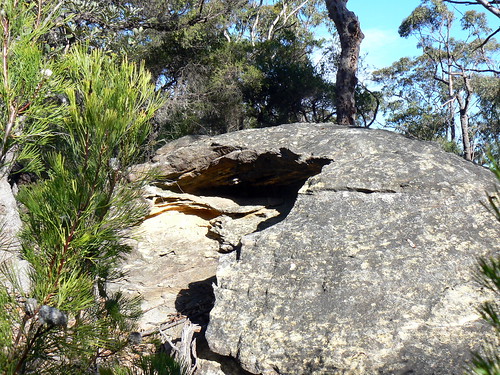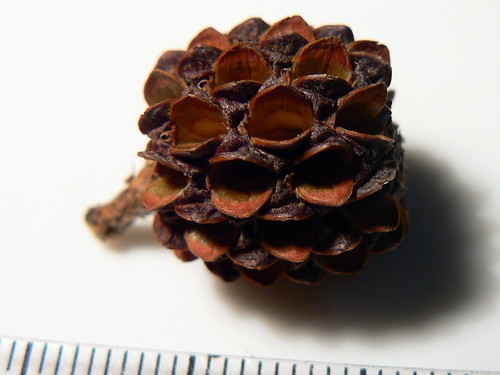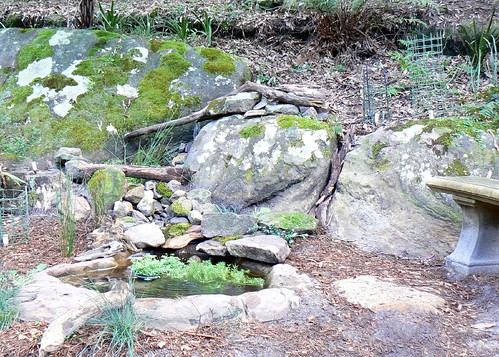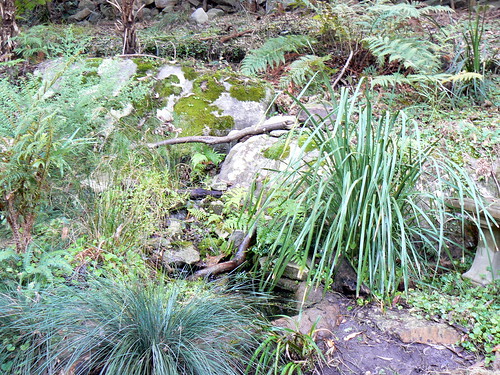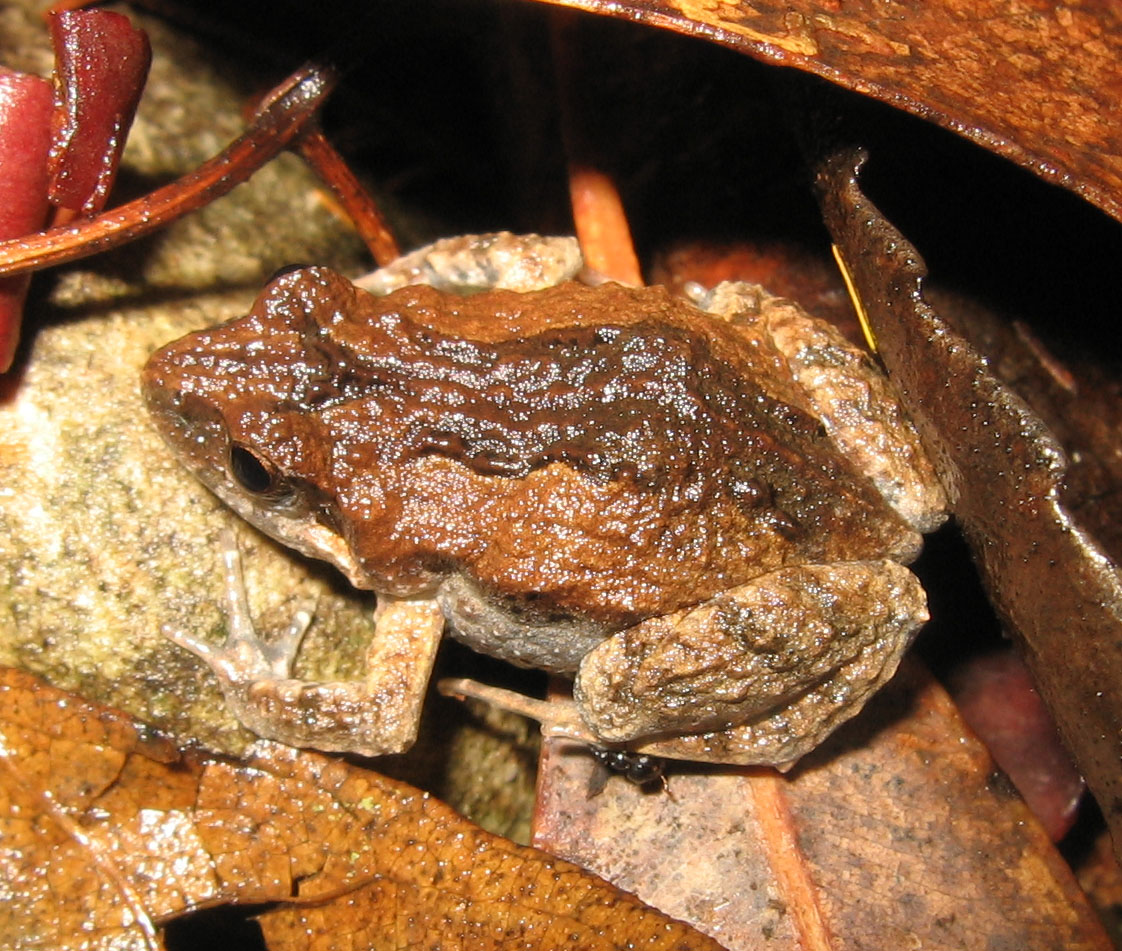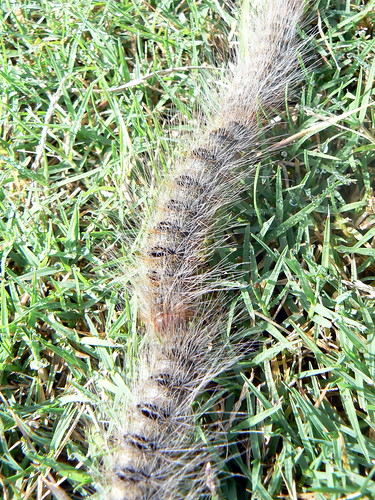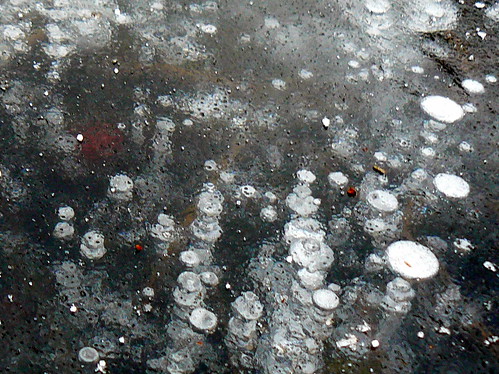The warm weather is really bringing out the insects! I took this photo of a male mantid a couple of nights ago.
The mantid was on the ceiling (hmm, needs cleaning) when I shot this while precariously standing on a chair. (The image has been inverted.) Mantids are from the Order Mantodea, and are excellent predators of other invertebrates.
This photo is of a female, shot through a window (hmm, also needs cleaning). It's eating a beetle.
Here's another female, resident of Macquarie University Biology Department:
My daughter has a growing interest in insects, and is planning to keep a mantid as a pet. So expect many more photos of these gorgeous creatures!
Friday, December 18, 2009
Thursday, December 03, 2009
The Bird and the Spider.
No particular theme today, but two animals that caught my fancy.
The first is a black house spider, Badumna insignis. It's a common sight in Australian gardens and houses. While not too dangerous, it is poisonous and can badly affect sensitive folk. I'm trying to improve my skills in photographing arthropods, but it isn't easy! Focus, lighting....
The second species is becoming a frequent visitor to Sydney gardens, particularly since baiting of foxes (one of Australia's many mammal weeds!) is starting to take effect. While brush turkeys (Alectura lathami) are well known for foraging in mulch, building mounds in inconvenient spots and generally causing general garden chaos, few realise that at night they roost in trees. That our garden is a popular place for them to roost is evidenced by the chunky piles of brush turkey poo we regularly find on our car.
I just took this shot, at dusk. It's remarkable that such a large bird (weighing around just under 2 kg) can roost so happily on what are really quite narrow branches.
Here's one I prepared earlier:
The first is a black house spider, Badumna insignis. It's a common sight in Australian gardens and houses. While not too dangerous, it is poisonous and can badly affect sensitive folk. I'm trying to improve my skills in photographing arthropods, but it isn't easy! Focus, lighting....
The second species is becoming a frequent visitor to Sydney gardens, particularly since baiting of foxes (one of Australia's many mammal weeds!) is starting to take effect. While brush turkeys (Alectura lathami) are well known for foraging in mulch, building mounds in inconvenient spots and generally causing general garden chaos, few realise that at night they roost in trees. That our garden is a popular place for them to roost is evidenced by the chunky piles of brush turkey poo we regularly find on our car.
I just took this shot, at dusk. It's remarkable that such a large bird (weighing around just under 2 kg) can roost so happily on what are really quite narrow branches.
Here's one I prepared earlier:
Sunday, November 29, 2009
Angophora costata
The Sydney Red Gum, Angophora costata, is a particularly beautiful tree, especially in spring when its normally smooth bark flakes away to expose the new season's pinky-grey bark beneath.
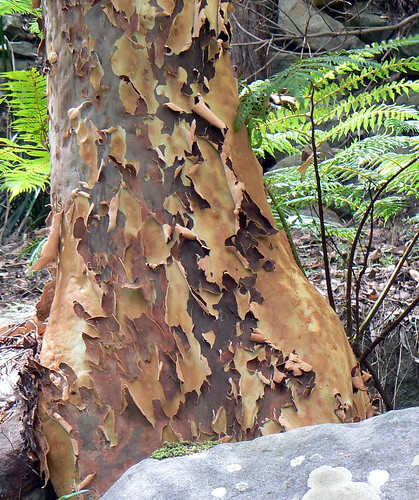
Angophora costata is found across a range of eastern coastal regions in Australia, and they are common in the sandstone soil of the Hawkesbury area. They are not of the genus Eucalyptus, but are closely related. One way to distinguish them is that Angophora leaves grow opposite each other on the stem, while in Eucalyptus species they alternate.
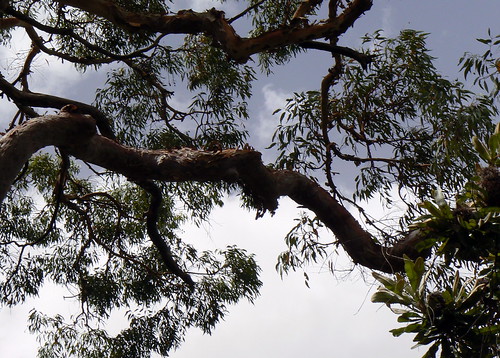
We have a few mature specimens in our garden, and they provide shade and habitat for a multitude of creatures. Their heavy limbs also have a tendency to shatter, alas. Just over two years ago, a large tree fell over on our house.
I recently bought a pair of earrings made from A. costata leaves. The leaves were treated with acid, removing all leaf tissue but the skeleton, and then dipped in gold. It's not easy to see from this photo, but against the light you can see the filigree pattern. Ideal for a planty person's lobes!
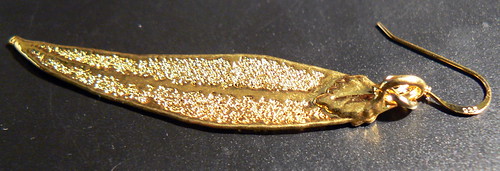

Angophora costata is found across a range of eastern coastal regions in Australia, and they are common in the sandstone soil of the Hawkesbury area. They are not of the genus Eucalyptus, but are closely related. One way to distinguish them is that Angophora leaves grow opposite each other on the stem, while in Eucalyptus species they alternate.

We have a few mature specimens in our garden, and they provide shade and habitat for a multitude of creatures. Their heavy limbs also have a tendency to shatter, alas. Just over two years ago, a large tree fell over on our house.

Wednesday, November 11, 2009
Fauna less loved: bloodsuckers.
I often wax lyrical in this blog about the flora and fauna in our garden, but some species are less welcome than others. Here are a couple of invertebrates that can make gardening a little hazardous.
This is a paralysis tick, Ixodes holocyclus. It's only tiny when it hasn't been feeding: this specimen is only 1.5mm in body length.When they're engorged with blood, they increase in size by many times.
Ixodes holocyclus is indigenous to the east coast of Australia, and its food source is primarily the blood of marsupials such as wallabies, bandicoots and possums. Domestic cats and dogs are particularly vulnerable to them in bushland areas, and without treatment can die. Human fatalities have become far less common since the development of an anti-toxin.A couple of months ago, a paralysis tick made its way into my bra, and injected me with its toxin. By next day, the inflammation on my breast (lovely soft flesh--a tick's delight!) was the size of a saucer, raised, hot and very painful. It took a course of antibiotics, antihistamines, steroid cream and many sleepless nights before it subsided.
Ticks are in the class Arachnida, like spiders and scorpions, and thus have eight legs.
While waiting for prey, the leech anchors itself by its posterior sucker and raises its body up. It senses potential victims by vibrations and chemical sensing, and attaches to the skin by its mouth. Then it injects anticoagulants and histamines to stop the blood from clotting and allow it to flow freely into the leech. Amazingly, it's easy to miss that a leech has attached to you. It's only after it's full and drops off to digest your precious bodily fluids, that you notice the itch---and the blood freely pouring out of the wound. If you're prone to allergies, like me, a nasty hot, itchy welt can develop.
Much as I loathe their effect, I do have a grudging admiration for leeches. They mark a significant evolutionary development from less derived species, because their body segmentation improves their mobility--something very evident when you watch one weaving through the air after it's sensed your presence. Leeches are hermaphrodites, and cross-fertilise during sex. In the phylum Annelida, they are related to common garden worms, but most of their near relatives are marine.
Next time, friendlier species, I promise!
This is a paralysis tick, Ixodes holocyclus. It's only tiny when it hasn't been feeding: this specimen is only 1.5mm in body length.When they're engorged with blood, they increase in size by many times.
Ixodes holocyclus is indigenous to the east coast of Australia, and its food source is primarily the blood of marsupials such as wallabies, bandicoots and possums. Domestic cats and dogs are particularly vulnerable to them in bushland areas, and without treatment can die. Human fatalities have become far less common since the development of an anti-toxin.A couple of months ago, a paralysis tick made its way into my bra, and injected me with its toxin. By next day, the inflammation on my breast (lovely soft flesh--a tick's delight!) was the size of a saucer, raised, hot and very painful. It took a course of antibiotics, antihistamines, steroid cream and many sleepless nights before it subsided.
Ticks are in the class Arachnida, like spiders and scorpions, and thus have eight legs.
Another bloodsucker frequenting our garden is the leech. The species below is (most likely) the Australian Land Leech, Gnatbobdellida libbata, which has evolved to live out of water, and becomes active after rain.
While waiting for prey, the leech anchors itself by its posterior sucker and raises its body up. It senses potential victims by vibrations and chemical sensing, and attaches to the skin by its mouth. Then it injects anticoagulants and histamines to stop the blood from clotting and allow it to flow freely into the leech. Amazingly, it's easy to miss that a leech has attached to you. It's only after it's full and drops off to digest your precious bodily fluids, that you notice the itch---and the blood freely pouring out of the wound. If you're prone to allergies, like me, a nasty hot, itchy welt can develop.
Much as I loathe their effect, I do have a grudging admiration for leeches. They mark a significant evolutionary development from less derived species, because their body segmentation improves their mobility--something very evident when you watch one weaving through the air after it's sensed your presence. Leeches are hermaphrodites, and cross-fertilise during sex. In the phylum Annelida, they are related to common garden worms, but most of their near relatives are marine.
Next time, friendlier species, I promise!
Sunday, October 25, 2009
Springing!
Again, I've been lax with my poor untended blog. I've been very busy of late, with studies, research and now, being president of Macquarie University Biological Society (MUBS). We've launched a new website and newsletter, mRNA. If you're interested in biology, I hope you'll go and take a look! As well as these innovations, we're planning monthly lunchtime biology talks and a competition and exhibition of biology photos taken by students and staff in the faculty. I'm now also on the Macquarie University Biology Museum Advisory Group, looking at upgrading the museum. Exciting times ahead!
As the weather is warming up, and we're finally having some good rain, the garden is taking off. Finally, many of the plants that I put in when we moved here are tall enough to avoid the chomping teeth of the wallabies. Because I've been mulching and watering so much, it seems that the invertebrate life in the soil has become utterly irresistible to the Brush Turkeys and Superb Lyrebirds, who every day kindly "aerate" the soil. We're constantly having to shovel mulch off the paths and back onto the garden beds.
Some recent garden photos:
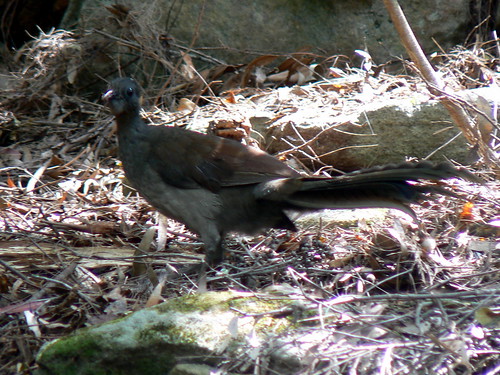
A Superb Lyrebird, Menura novaehollandiae. It's hard to get a good shot of these, as they're so timid. This one appears to be a juvenile male, with its elaborate tail plumage beginning to develop. There's been a lot of lyrebird courtship going on, with males pursuing females through the garden and wooing with their extraordinary repertoire. I completely forgive them for the damage they do to the garden. Their presence is, well, superb!
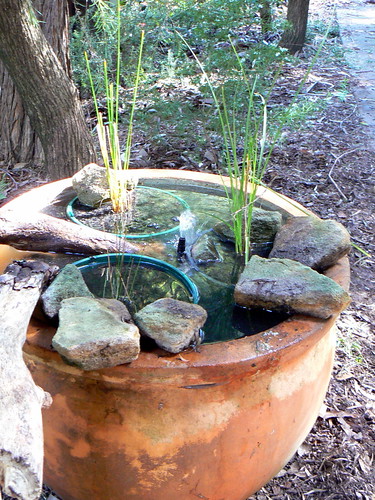
In addition to our old pond, we've added another frog habitat: a large, sealed terracotta pot. I've planted some emergent monocots in it, hoping to attract another species of frog, the Eastern Dwarf Green Tree Frog, Littoria fallax. As these plants grow, they'll conceal the plastic pots, and I've planted some densely growing plants around it, to provide protection. The pump is solar powered, with a solar panel on the roof in one of the few spots at our place that gets regular sunlight.
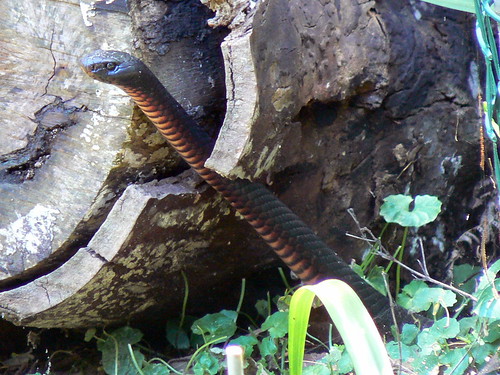
This is a new visitor to our garden, a Red Bellied Black Snake, Pseudechis porphyriacus. It's around 1.5 metres in length. Although venomous, it's a cautious species and so I'm not too concerned about its presence. The frogs might be though!
My end of year exams will be over in around a month, and I hope to spend lots of time in the garden and blogging, so I'll see you then!
Friday, July 03, 2009
Germination
In May, I collected some seeds, including Hakea sericea and Allocasuarina littoralis. They have now germinated, and what pretty little things they are.
In both cases, the contrast between the cotyledons (embryonic leaves) and the first "true leaves" is stark. In dicotyledons, the two cotyledons form inside the embryo inside the seed and emerge after germination. They are soon replaced by leaves that are much closer in structure to those of the mature plant.
In the Allocasuarina littoralis, the small scale-like leaves are already visible along the main stem. The specimen above is around 3 cm tall.
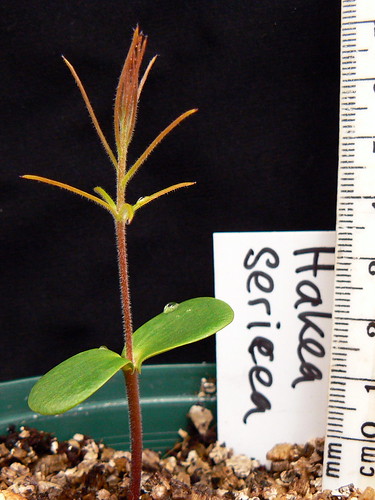
In both cases, the contrast between the cotyledons (embryonic leaves) and the first "true leaves" is stark. In dicotyledons, the two cotyledons form inside the embryo inside the seed and emerge after germination. They are soon replaced by leaves that are much closer in structure to those of the mature plant.
In the Allocasuarina littoralis, the small scale-like leaves are already visible along the main stem. The specimen above is around 3 cm tall.

The true leaves of the Hakea sericea display the sharp needle-like structure of mature leaves, but are still very soft in comparison with the brutal barbs it'll have when it grows up.
When all the seedlings have reached around 10 cm in height, I'll pot them up into tube stock tubes, and move them out of the glass house, and put them into the shade house. That will give them time to harden up in a relatively sheltered environment, and perhaps be ready to go in the garden by next autumn.
When all the seedlings have reached around 10 cm in height, I'll pot them up into tube stock tubes, and move them out of the glass house, and put them into the shade house. That will give them time to harden up in a relatively sheltered environment, and perhaps be ready to go in the garden by next autumn.
Saturday, May 30, 2009
Kitchen Bench Propagation
Pottering in the garden on a weekend is great when it's fine, but today it's raining so I did my gardening in the kitchen, propagating the seeds I recently collected as well as doing some cuttings from plants in the garden.
This tray is something I picked up a few years ago, and it is brilliant for propagating both seed and cuttings. The pots have lids (see top right) that allow you to keep the seedlings or cuttings protected, as well as regulating water loss. The pots sit on sponges which you keep wet, and the soil draws up moisture as needed.
So the Allocasuarina littoralis and Hakea sericea seeds you might remember from my previous post. I've made cuttings of three other plants:
The first is Adenanthos sericea, Albany Woolly Bush, a West Australian species I'm growing in a pot. It's getting a bit large for the pot and a little tired, so some offspring are timely. As you can see from the photos in the link above, it looks like its leaves should be sharp and tough like those of Hakea sericea, but in fact they're soft and delicate. It's a very beautiful shrub/tree.
Next is Hibbertia scandens, a local twiner which propagates from cuttings very easily. It flowers year round--I took this photo this afternoon.
And finally, Elaeocarpus reticulatus, Blueberry Ash, which produces either white or pink flowers and bright blue berries, beloved of birds. As you can see, we have the white flowered variety.
All these cuttings are semi-hardwood. That means it's not the most recent growth, nor old growth, but something in between that still has vigor but is more substantial than the new growth used in soft-tip cuttings. Autumn is the best time for semi-hardwood cuttings.
As a propagating mix, I used 1:1 peat moss and vermiculite, a quite versatile and handy mineral that assists in ensuring that the growing medium is well aerated. I also use it to cover seeds when they're sown, to gently hold them down and keep them moist.
When you're making cuttings, it's important to make your final cut at the bottom just below a node. The node is where the meristematic tissue is--basically, the same as embryonic stem cells in humans, able to differentiate into a variety of cell types. When you're doing cuttings, you want them to become root cells.
It's also wise to remove most of the leaves, and cut half to two thirds off the remaining. Some leaves are needed so the plant can still photosynthesise, but plants transpire (lose water) through their leaves, and for a plant with no roots, water is at a premium. For the same reason, you need to keep their environment humid.
Humidity, of course, brings its own problems, mainly in the form of fungal infection. Whenever I propagate with cuttings or seeds, I first wash all my pots in a dilute solution of bleach, then rinse. "Damping off" is a form of fungal disease that can easily kill tiny seedlings, the stems essentially being eaten away.
To give your cuttings a high chance of success, rooting hormone is a good idea. This is basically auxin, a plant hormone. Auxin's quite remarkable stuff. It is found in the shoot and root tips of plants, and its presence there ensures that tip's dominance, and suppresses the growth of competitors. When you remove the main shoot of a plant (by tip pruning, for example), that suppression ceases, and the apical buds in the nodes (near where the leaves attach to the stem) then begin to grow new shoots. Thus by tip pruning, you can make your plant nice and bushy, especially if you begin tip pruning when they're still very young . Applying auxin to the basal cut of a cutting stimulates root growth there--especially if it's just below a node.
Now I know you're just aching to know how the dreaded Persoonia pinifolia seeds I talked about last post are coming along. Hmm. Not great.
Having soaked them for a couple of days, I tried breaching the endocarp, and succeeded in cutting the embryo in half. Whoops. This photo shows just how solid and relatively thick the endocarp is!
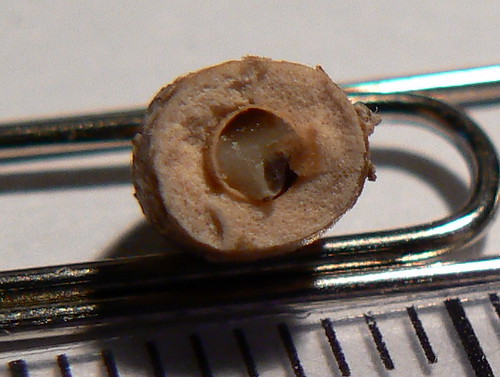
Scale: 1mm.
This tray is something I picked up a few years ago, and it is brilliant for propagating both seed and cuttings. The pots have lids (see top right) that allow you to keep the seedlings or cuttings protected, as well as regulating water loss. The pots sit on sponges which you keep wet, and the soil draws up moisture as needed.
So the Allocasuarina littoralis and Hakea sericea seeds you might remember from my previous post. I've made cuttings of three other plants:
The first is Adenanthos sericea, Albany Woolly Bush, a West Australian species I'm growing in a pot. It's getting a bit large for the pot and a little tired, so some offspring are timely. As you can see from the photos in the link above, it looks like its leaves should be sharp and tough like those of Hakea sericea, but in fact they're soft and delicate. It's a very beautiful shrub/tree.
Next is Hibbertia scandens, a local twiner which propagates from cuttings very easily. It flowers year round--I took this photo this afternoon.
And finally, Elaeocarpus reticulatus, Blueberry Ash, which produces either white or pink flowers and bright blue berries, beloved of birds. As you can see, we have the white flowered variety.
All these cuttings are semi-hardwood. That means it's not the most recent growth, nor old growth, but something in between that still has vigor but is more substantial than the new growth used in soft-tip cuttings. Autumn is the best time for semi-hardwood cuttings.
As a propagating mix, I used 1:1 peat moss and vermiculite, a quite versatile and handy mineral that assists in ensuring that the growing medium is well aerated. I also use it to cover seeds when they're sown, to gently hold them down and keep them moist.
When you're making cuttings, it's important to make your final cut at the bottom just below a node. The node is where the meristematic tissue is--basically, the same as embryonic stem cells in humans, able to differentiate into a variety of cell types. When you're doing cuttings, you want them to become root cells.
It's also wise to remove most of the leaves, and cut half to two thirds off the remaining. Some leaves are needed so the plant can still photosynthesise, but plants transpire (lose water) through their leaves, and for a plant with no roots, water is at a premium. For the same reason, you need to keep their environment humid.
Humidity, of course, brings its own problems, mainly in the form of fungal infection. Whenever I propagate with cuttings or seeds, I first wash all my pots in a dilute solution of bleach, then rinse. "Damping off" is a form of fungal disease that can easily kill tiny seedlings, the stems essentially being eaten away.
To give your cuttings a high chance of success, rooting hormone is a good idea. This is basically auxin, a plant hormone. Auxin's quite remarkable stuff. It is found in the shoot and root tips of plants, and its presence there ensures that tip's dominance, and suppresses the growth of competitors. When you remove the main shoot of a plant (by tip pruning, for example), that suppression ceases, and the apical buds in the nodes (near where the leaves attach to the stem) then begin to grow new shoots. Thus by tip pruning, you can make your plant nice and bushy, especially if you begin tip pruning when they're still very young . Applying auxin to the basal cut of a cutting stimulates root growth there--especially if it's just below a node.
Now I know you're just aching to know how the dreaded Persoonia pinifolia seeds I talked about last post are coming along. Hmm. Not great.
Having soaked them for a couple of days, I tried breaching the endocarp, and succeeded in cutting the embryo in half. Whoops. This photo shows just how solid and relatively thick the endocarp is!

Scale: 1mm.
There were three seeds left, but I stupidly left them on the kitchen counter in a bowl. My husband just got home and cleaned up.... Well, we rescued two from the sink. This is clearly the downside of kitchen bench propagation.
I'm going to attempt to file off the endocarps. I may be gone for some time....
Edited to add: If you're interested in propagating native plants, I couldn't recommend this book more highly. Angus Stewart's "Let's Propagate: A Plant Propagation Manual for Australia". Not only does he provide good advice on methods, he also has a comprehensive listing of Australian plant genera, and what method works best with each.
I'm going to attempt to file off the endocarps. I may be gone for some time....
Edited to add: If you're interested in propagating native plants, I couldn't recommend this book more highly. Angus Stewart's "Let's Propagate: A Plant Propagation Manual for Australia". Not only does he provide good advice on methods, he also has a comprehensive listing of Australian plant genera, and what method works best with each.
Wednesday, May 20, 2009
Persoonia pinifolia seed propagation... I hope!
Persoonia pinifolia is a notoriously difficult species to propagate by seed. So I've set myself the challenge!
Also known as the Pine-leaved Geebung, this species of shrub is indigenous to a small region of Australia, between Broken Bay to the Royal National Park and the lower Blue Mountains. The difficulty in germinating appears to be caused by the hard, dense endocarp surrounding the seed embryo.

Also known as the Pine-leaved Geebung, this species of shrub is indigenous to a small region of Australia, between Broken Bay to the Royal National Park and the lower Blue Mountains. The difficulty in germinating appears to be caused by the hard, dense endocarp surrounding the seed embryo.

On the left, is an unripe fruit (a drupe), as I collected it from the shrub. In the centre, a ripened drupe. I facilitated the ripening by keeping it in a paper bag along with a ripe banana for a few days. Bananas when mature release the gas ethylene, which is an important plant growth hormone. (If you have a bunch of bananas that aren't ripe, and you put them in a bag with a ripe banana, all will ripen quickly. Handy, huh?)
On the right is a seed with the flesh of the drupe--the seed's exocarp--removed. What you can see is the endocarp, and inside that is the embryo.
Many species of seed need to have their endocarp breached in some way to allow the influx of water and oxygen so the embryo can germinate. There are many ways of doing this, depending on species and their evolution. Sometimes, the seed is placed in boiling water, as with Acacia seeds. Another methods include abrading or piercing the endocarp, or burning the seed. Seed dormancy can also be overcome by stratification (chilling) in the case of seeds from alpine and semi-alpine habitats, or by the application of water through which smoke has been bubbled.
Just about everything has been attempted on Persoonia seeds by various horticulturists and plant scientists, without much success. One paper, "Propagation of Persoonia virgarta for the development of a new floricultural export crop," by Lynda Maree Bauer (ne Ketelhohn) and Margaret Johnston of the University of Queensland, suggests that one of the major factors inhibiting germination is the sheer hardness of the endocarp. Merely abrading or piecing it is insufficient, suggesting that there is in part a simple mechanical barrier to seed growth.
So taking their research as my guide, I am going to try to break down the endocarps. Having removed the exocarps, I'm now soaking the seeds in water in an attempt to soften the endocarps by fermentation, and then will use pliers to remove them. The risk here, of course, is that I damage the embryos, and there is also a real possibility of contamination by bacteria or fungi.
Thus it might all end up in a heap of failure, but it's worth a try. If I don't succeed, the next step will be to try propagating Persoonia pinifolia by cuttings. Apparently that's not always successful, but more efficacious than by seed. Watch this space!
On the right is a seed with the flesh of the drupe--the seed's exocarp--removed. What you can see is the endocarp, and inside that is the embryo.
Many species of seed need to have their endocarp breached in some way to allow the influx of water and oxygen so the embryo can germinate. There are many ways of doing this, depending on species and their evolution. Sometimes, the seed is placed in boiling water, as with Acacia seeds. Another methods include abrading or piercing the endocarp, or burning the seed. Seed dormancy can also be overcome by stratification (chilling) in the case of seeds from alpine and semi-alpine habitats, or by the application of water through which smoke has been bubbled.
Just about everything has been attempted on Persoonia seeds by various horticulturists and plant scientists, without much success. One paper, "Propagation of Persoonia virgarta for the development of a new floricultural export crop," by Lynda Maree Bauer (ne Ketelhohn) and Margaret Johnston of the University of Queensland, suggests that one of the major factors inhibiting germination is the sheer hardness of the endocarp. Merely abrading or piecing it is insufficient, suggesting that there is in part a simple mechanical barrier to seed growth.
So taking their research as my guide, I am going to try to break down the endocarps. Having removed the exocarps, I'm now soaking the seeds in water in an attempt to soften the endocarps by fermentation, and then will use pliers to remove them. The risk here, of course, is that I damage the embryos, and there is also a real possibility of contamination by bacteria or fungi.
Thus it might all end up in a heap of failure, but it's worth a try. If I don't succeed, the next step will be to try propagating Persoonia pinifolia by cuttings. Apparently that's not always successful, but more efficacious than by seed. Watch this space!
Monday, May 18, 2009
Seeds
A couple of days ago, we went for a walk in the Berowra Valley Regional Park near our home, and I collected a few seeds of local plants for propagating. It's a stunning nature reserve situated on the Hawkesbury Sandstone Plateau from the Middle Triassic period, and has a great variety of flora.
One of the trees common to our local sclerophyll forests is Allocasuarina littoralis, Black Sheoak:
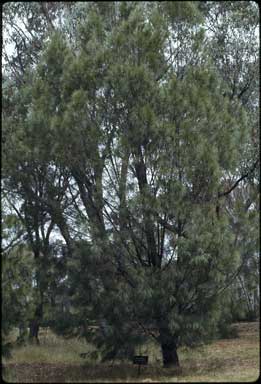 Image: Australian National Botanic Gardens
Image: Australian National Botanic Gardens
One of the trees common to our local sclerophyll forests is Allocasuarina littoralis, Black Sheoak:
 Image: Australian National Botanic Gardens
Image: Australian National Botanic GardensIt superficially resembles a pine, especially given its needle-like "leaves", but closer inspection shows that they are not leaves at all.
The gossamer wing on the right side of the seed is its samara, quite common in plants that use wind for the seed dispersal.
A far more spectacular seed and fruit comes from Hakea sericea, a member of the Proteaceae family. It's remarkable to realise that from these delicate flowers...

Scale: 1mm
In this photo, you can see two sets of the tiny, tooth-shaped leaves on the modified stem. The shape and number of these leaves is key to identifying the species within the genus. The leaves are minute, scarcely visible to the human eye, and clearly it is the stem that is responsible for the plant's photosynthesis. The similarity at first glance to pines is, in fact, an example of convergent evolution. The major difference between pines and members of the family is that while pines are conifers, the family Casuarinaceae are angiosperms: flowering plants.
Allocasuarina littoralis is dioceous, meaning that male and female sexual parts occur on separate trees. Thus at this time of year, roughly half will be in fruit--the females. They flower in spring, with reddish flowers on the females, and dark brown flowers on the males.
After collecting the fruits, I cajoled them to open and release their seed in accordance with the ancient custom: putting them in a paper bag and leaving them on the dashboard of the car for a couple of days. Even in relatively cool weather, this heats them sufficiently for them to open.
Here is a fruit, opened up:
And here is a seed:
Allocasuarina littoralis is dioceous, meaning that male and female sexual parts occur on separate trees. Thus at this time of year, roughly half will be in fruit--the females. They flower in spring, with reddish flowers on the females, and dark brown flowers on the males.
After collecting the fruits, I cajoled them to open and release their seed in accordance with the ancient custom: putting them in a paper bag and leaving them on the dashboard of the car for a couple of days. Even in relatively cool weather, this heats them sufficiently for them to open.
Here is a fruit, opened up:
And here is a seed:
The gossamer wing on the right side of the seed is its samara, quite common in plants that use wind for the seed dispersal.
A far more spectacular seed and fruit comes from Hakea sericea, a member of the Proteaceae family. It's remarkable to realise that from these delicate flowers...

...will develop to become these large, woody fruits...
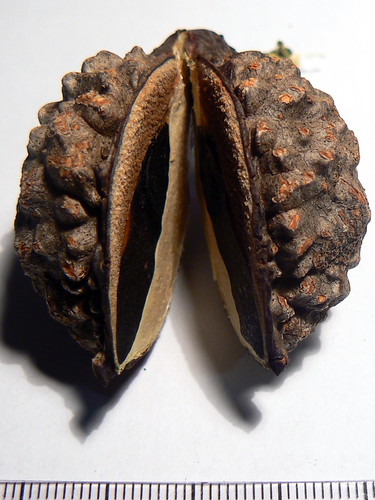

This fruit has split open, again by means of the car dashboard. The two black seeds are visible inside.


Like the seed of the Allocasuarina, the much larger Hakea seed also has a samara. That the fruit is so large and solid, and in terms of production, energy-expensive, can perhaps be explained by the fruit remaining closed until the shrub dies or until it is consumed by fire. It might have to protect the seeds for many years before it is time for them to germinate. Hakea leaves are perilously prickly and hard. Falling onto one would not be fun.
I'll be germinating the seeds from both species shortly, and will follow their growth and development here. There are few things more satisfying than growing plants that are indigenous to your own region, knowing that they'll fit perfectly into the ecosystem of your garden!
I'll be germinating the seeds from both species shortly, and will follow their growth and development here. There are few things more satisfying than growing plants that are indigenous to your own region, knowing that they'll fit perfectly into the ecosystem of your garden!
Saturday, May 09, 2009
Autumn flowers
Now that the weather's cooling down, I'm so enjoying pottering about the garden. We've done quite a bit of weeding (mainly bracken) and most of the plants we've put in are doing well. There were a few casualties during the summer heat, but nothing heart-breaking. Here are some photos of recent blooms.


This is Epacris longiflora, or Fuchsia Heath. It loves shady sandstone cliff faces in schlerophyll forest, and is found from NSW up through Queensland. The flower tubes in this specimen are around 15 millimetres long.
Friday, April 24, 2009
Our frog pond, then and now.
Eighteen months ago, we put a pond into our garden. As I was working on it today, cleaning out algae and overgrown pond plants, I wondered what it would be like to compare then and now. It's quite a contrast!
Edited to add: This is the link to my old website, in which I follow the process of building the pond. Lots of trial and error!
We have a number of frogs living there, but only two species so far.
Crinia signifera, the Common Froglet:
...and the ubiquitous Limnodynastes peronii, Striped Marsh Frog:
Perhaps not a wildly diverse range of species, but I'm just delighted to have them living here. And we have to compete with the creek behind our property, so we're lucky that they decided to move in!
September 2007
April 2009 -- It's a jungle out there.
Edited to add: This is the link to my old website, in which I follow the process of building the pond. Lots of trial and error!
We have a number of frogs living there, but only two species so far.
Crinia signifera, the Common Froglet:
Frog images: Wikipedia
Perhaps not a wildly diverse range of species, but I'm just delighted to have them living here. And we have to compete with the creek behind our property, so we're lucky that they decided to move in!
A Procession of Caterpillars
This morning, while walking the dogs at our local park, my husband spied what he initially thought was a ridiculously long worm rivalling the dimensions of the Giant Gippsland Earthworm.
But on closer inspection, he realised it was a procession of caterpillars....
These are Ochrogaster lunifer, commonly and sensibly known as Processionary Caterpillars and found across much of Australia. The procession was two to three metres long, consisting of nearly seventy individuals.
During the day, these caterpillars nest communally on the branches of the plants that form their diet: Acacia species. By night, they eat, eventually completely defoliating the tree, and then move on to find another.
They travel as they were this morning in a search for a suitable area in which to metamorphose into moths. It makes a lot of sense for them to congregate in this manner, as by appearing to be one large organism, they are less attractive to predators. In addition, their hairs (and those of the adult moth) can cause urticaria, a painful and persistent rash, also a good form of deterrence against anything considering them a potential lunch.
But on closer inspection, he realised it was a procession of caterpillars....
These are Ochrogaster lunifer, commonly and sensibly known as Processionary Caterpillars and found across much of Australia. The procession was two to three metres long, consisting of nearly seventy individuals.
During the day, these caterpillars nest communally on the branches of the plants that form their diet: Acacia species. By night, they eat, eventually completely defoliating the tree, and then move on to find another.
They travel as they were this morning in a search for a suitable area in which to metamorphose into moths. It makes a lot of sense for them to congregate in this manner, as by appearing to be one large organism, they are less attractive to predators. In addition, their hairs (and those of the adult moth) can cause urticaria, a painful and persistent rash, also a good form of deterrence against anything considering them a potential lunch.
Adult moth.
Links:- CSIRO Entomology - Australian Moths Online
- Australian Insects
- Van Schagen, J.J. and Majer, J.D. and Hobbs, R.J.. 1992. Biology of Ochrogaster lunifer Herrich-Schaeffer (Lepidoptera: Thaumetoedae), a defoliator of Acacia acuminata Bentham, in the Western Australian wheatbelt. Australian Entomological Magazine 19 (1): 19-24.
Tuesday, April 14, 2009
Swamp Wallaby
Another garden visitor, but one far more common than last post's diamond python. This is a swamp wallaby, Wallabia bicolor.
I took this photo from my study, overlooking the driveway. By the look of her, she's carrying a joey in her pouch.
Swamp wallabies are found throughout the east coast of Australia, their range extending around the coast to south-western Victoria. Their conservation status is secure, but they are less prevalent than they were, due to loss of habitat. They prefer dense forest undergrowth or sandstone heath.
They are the only species in their genus, it being suggested that they diverged from the genus Macropus some 6 million years ago. Unlike other wallabies, this species tends to eat small bushes and shrubs, rather than simply grazing on grasses. This, of course, is why my garden currently resembles a plastic tree-guard plantation. It's an ongoing battle to get my plants large enough to escape the wallabies' predations!
They breed throughout the year, often suckling an older joey while another is still in the pouch. Their gestation period is around 35 days, and the pouch period another nine months. Swamp wallabies grow to 66-85 cm in height, plus about the same length of tail, and weigh 13-17 kilos as adults.
I took this photo from my study, overlooking the driveway. By the look of her, she's carrying a joey in her pouch.
Swamp wallabies are found throughout the east coast of Australia, their range extending around the coast to south-western Victoria. Their conservation status is secure, but they are less prevalent than they were, due to loss of habitat. They prefer dense forest undergrowth or sandstone heath.
They are the only species in their genus, it being suggested that they diverged from the genus Macropus some 6 million years ago. Unlike other wallabies, this species tends to eat small bushes and shrubs, rather than simply grazing on grasses. This, of course, is why my garden currently resembles a plastic tree-guard plantation. It's an ongoing battle to get my plants large enough to escape the wallabies' predations!
They breed throughout the year, often suckling an older joey while another is still in the pouch. Their gestation period is around 35 days, and the pouch period another nine months. Swamp wallabies grow to 66-85 cm in height, plus about the same length of tail, and weigh 13-17 kilos as adults.
Sunday, March 29, 2009
Diamond Python
This beautiful creature I just met in our garden: a diamond python, Morelia spilota spilota.


Diamond pythons are found in bushland around the east coast of New South Wales and Victoria. In Victoria, it is considered endangered due to loss of habitat. They grow up to 4 metres long, and this one, I'd estimate, is around 2 metres.
It was basking next to our compost bin, probably because at night it becomes a smorgasbord for visiting mice. Diamond pythons are nocturnal, and kill their prey by constriction. Their diet is small mammals and lizards.
Unusually for snakes, the female diamond python nurtures her eggs by incubation.
It was basking next to our compost bin, probably because at night it becomes a smorgasbord for visiting mice. Diamond pythons are nocturnal, and kill their prey by constriction. Their diet is small mammals and lizards.
Unusually for snakes, the female diamond python nurtures her eggs by incubation.
Thursday, March 26, 2009
That funny old blogosphere.
A few days ago, PZ Myers of the blog Pharyngula posted my photo of two amorous Red Triangle Slugs (Triboniophorus graeffei). Pharyngula is one of the most popular science blogs online, so needless to say, the link brought more traffic to my humble blog than it is accustomed to...
That image (from my Statcounter) is a little blurry, but it shows that My Growing Passion leapt from a daily twenty or thirty unique visitors to nearly four hundred over three days. My photos on Flickr also generated masses more traffic.
Which just goes to show... not sure exactly what, except that I've been neglecting this blog unforgiveably and having lots of new visitors has reminded me of that.
Been very busy, with studying and working at my no longer new job, research assisting. The latter is proving wondrous good. I have quite a bit of autonomy, and a surprising level of "ownership" of the research. With luck, we'll get a paper out of it. And if we do, don't expect me to quiet about it here. I'll be screaming it from the blogtops! Tell me, is it truly daggy to frame a copy of the contents page of your first peer-reviewed journal publication? But I get ahead of myself. First, the experiments....
If you don't know Pharyngula and are not averse to the unabashed rantings of a brutally frank atheist-evolutionary scientist, you'll find much to enjoy there. It's become one of the blogs I simply must read every day. PZ's energy is amazing.
That image (from my Statcounter) is a little blurry, but it shows that My Growing Passion leapt from a daily twenty or thirty unique visitors to nearly four hundred over three days. My photos on Flickr also generated masses more traffic.
Which just goes to show... not sure exactly what, except that I've been neglecting this blog unforgiveably and having lots of new visitors has reminded me of that.
Been very busy, with studying and working at my no longer new job, research assisting. The latter is proving wondrous good. I have quite a bit of autonomy, and a surprising level of "ownership" of the research. With luck, we'll get a paper out of it. And if we do, don't expect me to quiet about it here. I'll be screaming it from the blogtops! Tell me, is it truly daggy to frame a copy of the contents page of your first peer-reviewed journal publication? But I get ahead of myself. First, the experiments....
If you don't know Pharyngula and are not averse to the unabashed rantings of a brutally frank atheist-evolutionary scientist, you'll find much to enjoy there. It's become one of the blogs I simply must read every day. PZ's energy is amazing.
Monday, February 09, 2009
Another Bloggy Meme
I really like this particular game of Blog-Tag, because it relates to one of my favourite subjects: science books. Thanks to Christie at Observations of a Nerd for tagging me.
And the blogs I'm tagging:
The Frontal Cortex
Richard Wiseman's Blog
Culture Dish
Pleiotropy
Bad Science
I hope they'll all carry on the meme-tag, because I'm very curious as to their choices!
Imagine: YOU are asked to assign a half-dozen-or-so books as required reading for ALL science majors at a college as part of their 4-year degree; NOT technical or text books, but other works, old or new, touching upon the nature of science, philosophy, thought, or methodology in a way that a practicing scientist might gain from.Okay, so my book selection:
Post your list, and forward the meme to a half-dozen-or-so other science-oriented bloggers of your choosing.
- John Gribbin, History of Western Science
- E.O. Wilson, Biophilia: The Human Bond with Other Species
- Daniel Dennett, Darwin's Dangerous Idea: Evolution and the Meanings of Life
- Jared Diamond, Guns, Germs and Steel: A Short History of Everybody for the Last 13,000 Years
- V.S. Ramachandran, Phantoms in the Brain
- Stephen Pinker, The Blank Slate: The Modern Denial of Human Nature
- Richard Dawkins, Unweaving the Rainbow
- Carl Zimmer, Microcosm: E. coli and the New Science of Life
And the blogs I'm tagging:
The Frontal Cortex
Richard Wiseman's Blog
Culture Dish
Pleiotropy
Bad Science
I hope they'll all carry on the meme-tag, because I'm very curious as to their choices!
Tuesday, February 03, 2009
Congratulations, High Court Judge Virginia Bell.
Thirty years ago, I was a law student. I lived in the inner city of Sydney, next door to a lovely fellow, who was young, pretty and gay. I'll call him Carl.
Carl liked the odd toke of the odd joint, and one day, he'd just bought a generous deal of cannabis. He was busted, arrested and sent to court. I accompanied him. I was only in second year at law school, so couldn't do much apart from hand-holding. He received a custodial sentence of 6 months. I remember the shock I felt as he was taken away, the look on his face.
Some weeks later, Carl rang me from Long Bay Prison. He was in despair, being raped nightly, and he begged me to help him. He gave me the name of his defence solicitor, to see if I could ask him to do something.
I rang the lawyer and explained what was happening. "Sorry," he told me. "I don't do after-sale service." They were his exact words. I was gobsmacked. Apart from the sheer financial selfishness he demonstrated, his lack of compassion was breathtaking.
So I contacted Redfern Legal Centre, a community/poverty law organisation largely staffed by volunteers, and made an appointment with their full time lawyer running the Prisoners' Legal Service. The woman I saw was understanding of my friend's plight, and put him down on her prison visiting list. She couldn't get him out of gaol, but she could give him advice and comfort. She helped him a lot.
This woman transformed my ideas about the law. I became a student volunteer at Redfern Legal Centre, working one night a week, and when I qualified, continued volunteering at nights at the Illawarra and Parramatta Legal Centres. She was smart, completely lacking in pretention, no bullshit, and incredibly well able and willing to take on the bully boys (and they were largely boys) in the legal profession and police.
Today, that woman was made one of the seven judges of the High Court of Australia, the highest court in the country. Virginia Bell, after Redfern Legal Centre, went on to private practice and Public Defender work, as a solicitor and then at the Bar. She was appointed to the NSW Supreme Court in 1995.
Virginia, as a Supreme Court judge, ruled that it is not defamatory to call someone gay, a landmark decision. She was a participant in the first Sydney Gay and Lesbian Mardi Gras in 1978, and defended some of those arrested for participating. Basically, the woman is a star and her appointment is a real milestone, and not only because she's only the fourth woman and the second openly gay member of the High Court bench (replacing the first, Michael Kirby), but because her record as a level-headed defender of human rights and social justice.
I am proud to remember High Court Justice Bell from way back when. And I think Carl will remember her well too.
Carl liked the odd toke of the odd joint, and one day, he'd just bought a generous deal of cannabis. He was busted, arrested and sent to court. I accompanied him. I was only in second year at law school, so couldn't do much apart from hand-holding. He received a custodial sentence of 6 months. I remember the shock I felt as he was taken away, the look on his face.
Some weeks later, Carl rang me from Long Bay Prison. He was in despair, being raped nightly, and he begged me to help him. He gave me the name of his defence solicitor, to see if I could ask him to do something.
I rang the lawyer and explained what was happening. "Sorry," he told me. "I don't do after-sale service." They were his exact words. I was gobsmacked. Apart from the sheer financial selfishness he demonstrated, his lack of compassion was breathtaking.
So I contacted Redfern Legal Centre, a community/poverty law organisation largely staffed by volunteers, and made an appointment with their full time lawyer running the Prisoners' Legal Service. The woman I saw was understanding of my friend's plight, and put him down on her prison visiting list. She couldn't get him out of gaol, but she could give him advice and comfort. She helped him a lot.
This woman transformed my ideas about the law. I became a student volunteer at Redfern Legal Centre, working one night a week, and when I qualified, continued volunteering at nights at the Illawarra and Parramatta Legal Centres. She was smart, completely lacking in pretention, no bullshit, and incredibly well able and willing to take on the bully boys (and they were largely boys) in the legal profession and police.
Today, that woman was made one of the seven judges of the High Court of Australia, the highest court in the country. Virginia Bell, after Redfern Legal Centre, went on to private practice and Public Defender work, as a solicitor and then at the Bar. She was appointed to the NSW Supreme Court in 1995.
Virginia, as a Supreme Court judge, ruled that it is not defamatory to call someone gay, a landmark decision. She was a participant in the first Sydney Gay and Lesbian Mardi Gras in 1978, and defended some of those arrested for participating. Basically, the woman is a star and her appointment is a real milestone, and not only because she's only the fourth woman and the second openly gay member of the High Court bench (replacing the first, Michael Kirby), but because her record as a level-headed defender of human rights and social justice.
I am proud to remember High Court Justice Bell from way back when. And I think Carl will remember her well too.
Oh, and on a completely different note, this blog's just been included in the Top 100 Botany Blogs by a group called "Online College Blog". Colour me chuffed! Thanks to whoever let them know about my little corner of the Net. :)
Sunday, January 25, 2009
Superb Lyrebird
As I've previously mentioned, some Superb Lyrebirds, Menura novaehollandiae frequent our garden. They're remarkably beautiful birds, their common name reflecting the the male's tale, which resembles an ornate musical lyre. Even more extraordinary than the plumage, however, is their famous song. Or songs....
This morning, we were delighted to hear one of the males performing his repertoire. It included the calls of an Eastern Rosella (Platycercus eximius), an Eastern Whipbird (Psopodes olivaceus), an Australian Magpie (Gymnorhina tibicen), a car alarm, the beep of an electronic car-key, and the frogs in the creek behind our house, Crinia signifera.
The Superb Lyrebird is quite large, the male being up to 100cm in length, including tale. They fossick in the leaf litter of moist forests in South-Eastern Australia, eating insects, worms and spiders. They roost in trees at night.
Their mimicry is, of course, all about getting girls. The male builds a mound to act as a stage where he throws his tale over his head, shakes it, and performs for half an hour or more. The complexity of his repertoire is directly proportional to his mating success.
The accuracy of their mimicry has to be heard to be believed, so here is a video of one being interviewed by David Attenborough.
Image: John Gould,
The birds of Australia 1840-48
The birds of Australia 1840-48
This morning, we were delighted to hear one of the males performing his repertoire. It included the calls of an Eastern Rosella (Platycercus eximius), an Eastern Whipbird (Psopodes olivaceus), an Australian Magpie (Gymnorhina tibicen), a car alarm, the beep of an electronic car-key, and the frogs in the creek behind our house, Crinia signifera.
The Superb Lyrebird is quite large, the male being up to 100cm in length, including tale. They fossick in the leaf litter of moist forests in South-Eastern Australia, eating insects, worms and spiders. They roost in trees at night.
Their mimicry is, of course, all about getting girls. The male builds a mound to act as a stage where he throws his tale over his head, shakes it, and performs for half an hour or more. The complexity of his repertoire is directly proportional to his mating success.
The accuracy of their mimicry has to be heard to be believed, so here is a video of one being interviewed by David Attenborough.
Thursday, January 22, 2009
Science Book Bliss
A break from uni and work has allowed me the delight of reading science just for fun. Two books (one I've finished, the other I've just started) are particularly recommended.
The first is "Microcosm: E. coli and the new science of life" by Carl Zimmer. Zimmer is a blogger (The Loom, associated with Discover Magazine) and science journalist, whose previous books include "Evolution: The Triumph of an Idea" and "Soul Made Flesh".

One of Hölldobler and Wilson's previous books, a massive monograph titled "The Ants", won them a Pulitzer Prize. This book mainly focuses on ants in its exploration of eusocial species. The book throws the reader head-first into a reignited debate on group selection. The understated style belies what is really quite controversial material.
Anyway, more soon. Only a few hundred more pages to go...
The first is "Microcosm: E. coli and the new science of life" by Carl Zimmer. Zimmer is a blogger (The Loom, associated with Discover Magazine) and science journalist, whose previous books include "Evolution: The Triumph of an Idea" and "Soul Made Flesh".
"Microcosm" gives a thorough overview of the evolution and functional diversity of E. coli, exploring its relation to humans and other species (as friend and foe) and the history of our understanding of the bacterium. But more significantly, Zimmer uses E. coli as a springboard to survey much beside, including cell biology, horizontal gene transfer, creationism (and its new disguise, "intelligent design"), astrobiology and the role of viruses in genetic diversity. It is written with passion and flair, and includes a comprehensive index, endnotes and bibliography, giving it great value for both biologists and general readers.
Recently, Zimmer gave a lecture on his book, podcast by Scientific American. Listen to Part 1 and Part 2.
The second book, of which I'm only just scratching the surface, I will write about in more detail when I've finished reading. It's "The Superorganism: The Beauty, Elegance and Strangeness of Insect Societies"by Bert Hölldobler and the wondrous E.O. Wilson.
Recently, Zimmer gave a lecture on his book, podcast by Scientific American. Listen to Part 1 and Part 2.
The second book, of which I'm only just scratching the surface, I will write about in more detail when I've finished reading. It's "The Superorganism: The Beauty, Elegance and Strangeness of Insect Societies"by Bert Hölldobler and the wondrous E.O. Wilson.

One of Hölldobler and Wilson's previous books, a massive monograph titled "The Ants", won them a Pulitzer Prize. This book mainly focuses on ants in its exploration of eusocial species. The book throws the reader head-first into a reignited debate on group selection. The understated style belies what is really quite controversial material.
Anyway, more soon. Only a few hundred more pages to go...
Monday, January 19, 2009
I've been tagged!
Christie Lynn, at Observations of a Nerd (a wonderful science blog.... do check it out!) has "tagged me".
Here are the rules:
1. Link to the person or persons who tagged you.
2. Post the rules on your blog.
3. Write six random and/or revealing things about yourself.
4. Tag six people at the end of your post and link to them.
5. Let each person know they’ve been tagged and leave a comment on their blog
6. Let the tagger know when your post entry is up on your site.
Six random/revealing things:
1. I have ridiculously vivid, detailed and epic dreams, and wake up with them still lingering in my head. For example, a couple of nights ago I dreamt I was at a scientific conference, and the Rolling Stones were there, along with entourage. They were all wearing suits made from sky-blue satin, including their manager, who had a broken arm. I was proudly explaining to the manager that when I was a lawyer, I successfully defended a very guilty serial killer. (And no, when I was a lawyer, I had no serial killer clients!)
2. According to Myers-Briggs, I am ENTJ (but I verge on the "I"); according to the "Big Five personality traits," I score high on openness, conscientiousness and agreeableness, medium on extraversion, and low on neuroticism.
3. Many years ago, before he took off in Hollywood, Russell Crowe vomited on my shoes at a party.
4. When I was thirteen, I was forced to do a forward dive roll off a little springboard and onto a mat during P.E. I warned the P.E. teacher that I couldn't do it. I told her I'd break my arm. She wouldn't listen. So I did it. And I broke both arms. Ha! That showed her.
5. I get very upset by weeds and have to make a conscious effort not to let them get me down when I catch the train and see along the sides of the tracks the jungles of morning glory, privet, lantana, ivy, pampas, etc, etc, etc. I have a very unscientific fantasy of a magic genetic bullet that kills every invasive exotic plant in Australia, although I would have exemptions for food crops and various exotic plants that some people, for reasons that elude me, like to grow in their gardens.
6. The most magical moment I've had when travelling was in Florence. I climbed the long, winding staircase to the top of Il Duomo late in the afternoon, and climbed out onto the balcony at dusk. The Tuscan hills were laid out in extraordinary colour, multiple hues of pastel blues, pinks, golds. And then, just as I was gazing out in the silence of the evening, the bells of the various cathedrals and churches of Florence began. They were out of synch, each tuned differently and varying in volume and distance, so it was a beautiful cacophony. When the Duomo itself joined in, it became deafening. Magnificent.
Blogs I'm tagging (and I hope you'll play along!):
1. Ben Pobjie's Wonderful World of Objects
2. LemonFarm - Capertee Valley
3. Kipili
4. Misrule
5. TechnoLlama
6. Sabino Canyon
Cheers,
Margaret
Here are the rules:
1. Link to the person or persons who tagged you.
2. Post the rules on your blog.
3. Write six random and/or revealing things about yourself.
4. Tag six people at the end of your post and link to them.
5. Let each person know they’ve been tagged and leave a comment on their blog
6. Let the tagger know when your post entry is up on your site.
Six random/revealing things:
1. I have ridiculously vivid, detailed and epic dreams, and wake up with them still lingering in my head. For example, a couple of nights ago I dreamt I was at a scientific conference, and the Rolling Stones were there, along with entourage. They were all wearing suits made from sky-blue satin, including their manager, who had a broken arm. I was proudly explaining to the manager that when I was a lawyer, I successfully defended a very guilty serial killer. (And no, when I was a lawyer, I had no serial killer clients!)
2. According to Myers-Briggs, I am ENTJ (but I verge on the "I"); according to the "Big Five personality traits," I score high on openness, conscientiousness and agreeableness, medium on extraversion, and low on neuroticism.
3. Many years ago, before he took off in Hollywood, Russell Crowe vomited on my shoes at a party.
4. When I was thirteen, I was forced to do a forward dive roll off a little springboard and onto a mat during P.E. I warned the P.E. teacher that I couldn't do it. I told her I'd break my arm. She wouldn't listen. So I did it. And I broke both arms. Ha! That showed her.
5. I get very upset by weeds and have to make a conscious effort not to let them get me down when I catch the train and see along the sides of the tracks the jungles of morning glory, privet, lantana, ivy, pampas, etc, etc, etc. I have a very unscientific fantasy of a magic genetic bullet that kills every invasive exotic plant in Australia, although I would have exemptions for food crops and various exotic plants that some people, for reasons that elude me, like to grow in their gardens.
6. The most magical moment I've had when travelling was in Florence. I climbed the long, winding staircase to the top of Il Duomo late in the afternoon, and climbed out onto the balcony at dusk. The Tuscan hills were laid out in extraordinary colour, multiple hues of pastel blues, pinks, golds. And then, just as I was gazing out in the silence of the evening, the bells of the various cathedrals and churches of Florence began. They were out of synch, each tuned differently and varying in volume and distance, so it was a beautiful cacophony. When the Duomo itself joined in, it became deafening. Magnificent.
Blogs I'm tagging (and I hope you'll play along!):
1. Ben Pobjie's Wonderful World of Objects
2. LemonFarm - Capertee Valley
3. Kipili
4. Misrule
5. TechnoLlama
6. Sabino Canyon
Cheers,
Margaret
Sunday, January 11, 2009
Become a "Follower" of my blog!
Sounds a little disciple-like, doesn't it? Mind you, "fan" isn't much better.
Anyway, you'll see on the top left of this page a little widget that allows blog readers to indicate (either anonymously or using their online name) they're following the blog. The idea is that by showing that this is a screamingly popular site (not that it is, but I do have plans to rule the world), I can get scads more readers, which would be jolly. It also allows you to be notified of updates to any Blogspot blog you're following.
So please, if you like this blog, click on the widget and let the cosmos know! (I am sure it will be fascinated.)
Cheers,
Margaret
Anyway, you'll see on the top left of this page a little widget that allows blog readers to indicate (either anonymously or using their online name) they're following the blog. The idea is that by showing that this is a screamingly popular site (not that it is, but I do have plans to rule the world), I can get scads more readers, which would be jolly. It also allows you to be notified of updates to any Blogspot blog you're following.
So please, if you like this blog, click on the widget and let the cosmos know! (I am sure it will be fascinated.)
Cheers,
Margaret
Saturday, January 10, 2009
Plants on (in!) Ice.
I've come home from freezing temperatures to days of over 30C, and over the last few weeks there's been little rain here. So I spent early Wednesday morning trying to cheer up a few of my more vulnerable plants with some deep watering. (Of course, as is in the nature of gardening, we had a thunderstorm that afternoon and everything got a good drink the old-fashioned way.)
A little reading (see below) on the subject has been very enlightening.
In order for plants to tolerate freezing, they must first undergo cold acclimation. A plant that has not been exposed to non-freezing cold might die at around -5C, while the same species that has been cold acclimatised can survive to -30C. This sort of temperature trigger is common in plants. Temperature changes induce flowering and seed production, and winter dormancy--as does changing day length.
The damage caused to plants by freezing occurs in cell membranes, with ice crystals forming in the spaces between the plant cells. This draws fluid from within the cells to these intercellular spaces. As a result, the cells become dehydrated, and this in turn damages the membranes themselves. One form of this damage is to the lipids--fat-soluble molecules--which help provide cell membrane structure. Cells can also rupture as a result of ice forming adhesions between cell walls and membranes. Further injury to the plant is possibly caused by protein denaturation, where the complex three-dimensional folding structure of a protein molecule is disrupted.
So how do some plants survive freezing temperatures and avoid this damage, and how does cold acclimation facilitate this?
It's been established that cold acclimation can change gene expression--that is, it triggers the replication of particular genes within the plant and thus the production of specific enzymes (proteins that act as a catalyst in a chemical reaction). A range of genes examined have various effects: some encode for a protein that alters lipid composition while others stabilise proteins against freeze-induced denaturation. There are many other genes expressed as a result of cold acclimation whose roles are not yet determined. In addition, low temperatures trigger a signal transduction cascade--essentially a domino effect of proteins acting upon each other within a cell. Calcium pours into the cell cytoplasm, triggering processes that induce gene expression.
None of this is going to have much import in my garden, whose main duty will be to stay alive during the increasing drought and heat of climate change. Still, looking at photos of chilly plants is a fine way to cool down!
Reference: Thomashow, M.F. 1999. Plant Cold Acclimation: Freezing Tolerance Genes and Regulatory Mechanisms. Annu. Rev. Plant Physiol. Plant Mol. Biol. 50:571–99. LINK.
The contrast between Here, in summer, and There, in winter, demonstrates the sort of extremes plants must tolerate in different ecosystems. I was fascinated by the sight in the Netherlands of plants coated in frost, and indeed, frozen in solid ice.
My mother-in-law's pond. Embedded in the ice are water lilies, and
beneath, just visible, are goldfish, content in the knowledge
that water expands when frozen and insulates them from
the air temperatures above.
Now, if you're from somewhere that has winters like these, you probably think I'm a parochial git for being so entranced by the novelty of plants coping with a serious winter. But from my balmy (ahem.... meteorologically speaking), temperate Sydney perspective, it's simply extraordinary.beneath, just visible, are goldfish, content in the knowledge
that water expands when frozen and insulates them from
the air temperatures above.
A little reading (see below) on the subject has been very enlightening.
In order for plants to tolerate freezing, they must first undergo cold acclimation. A plant that has not been exposed to non-freezing cold might die at around -5C, while the same species that has been cold acclimatised can survive to -30C. This sort of temperature trigger is common in plants. Temperature changes induce flowering and seed production, and winter dormancy--as does changing day length.
The damage caused to plants by freezing occurs in cell membranes, with ice crystals forming in the spaces between the plant cells. This draws fluid from within the cells to these intercellular spaces. As a result, the cells become dehydrated, and this in turn damages the membranes themselves. One form of this damage is to the lipids--fat-soluble molecules--which help provide cell membrane structure. Cells can also rupture as a result of ice forming adhesions between cell walls and membranes. Further injury to the plant is possibly caused by protein denaturation, where the complex three-dimensional folding structure of a protein molecule is disrupted.
So how do some plants survive freezing temperatures and avoid this damage, and how does cold acclimation facilitate this?
It's been established that cold acclimation can change gene expression--that is, it triggers the replication of particular genes within the plant and thus the production of specific enzymes (proteins that act as a catalyst in a chemical reaction). A range of genes examined have various effects: some encode for a protein that alters lipid composition while others stabilise proteins against freeze-induced denaturation. There are many other genes expressed as a result of cold acclimation whose roles are not yet determined. In addition, low temperatures trigger a signal transduction cascade--essentially a domino effect of proteins acting upon each other within a cell. Calcium pours into the cell cytoplasm, triggering processes that induce gene expression.
None of this is going to have much import in my garden, whose main duty will be to stay alive during the increasing drought and heat of climate change. Still, looking at photos of chilly plants is a fine way to cool down!
A clover plant by the side of the road in Belgium,
just before the snow dumped on it.
just before the snow dumped on it.
Reference: Thomashow, M.F. 1999. Plant Cold Acclimation: Freezing Tolerance Genes and Regulatory Mechanisms. Annu. Rev. Plant Physiol. Plant Mol. Biol. 50:571–99. LINK.
Subscribe to:
Posts (Atom)
